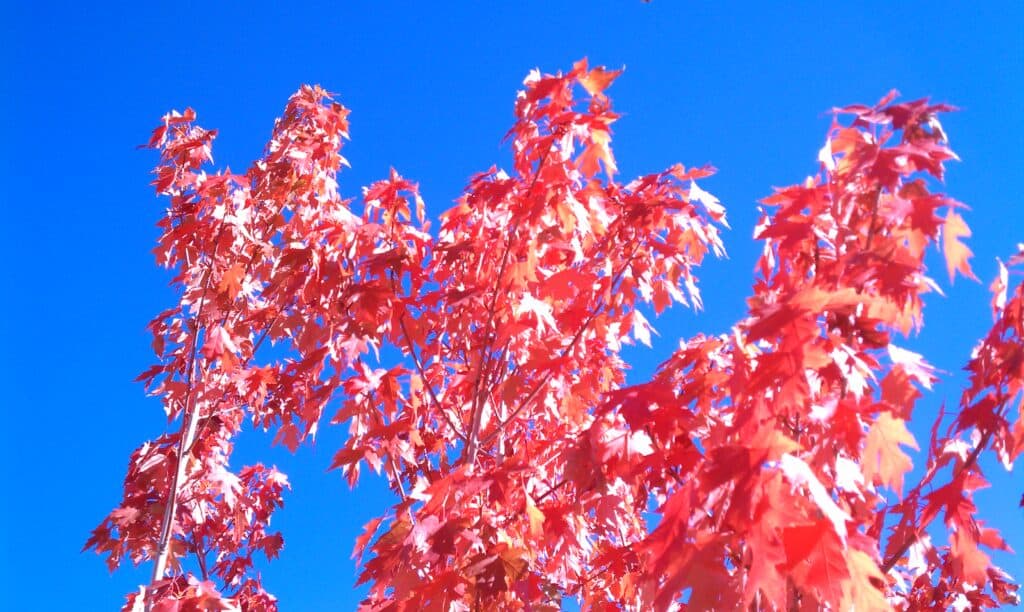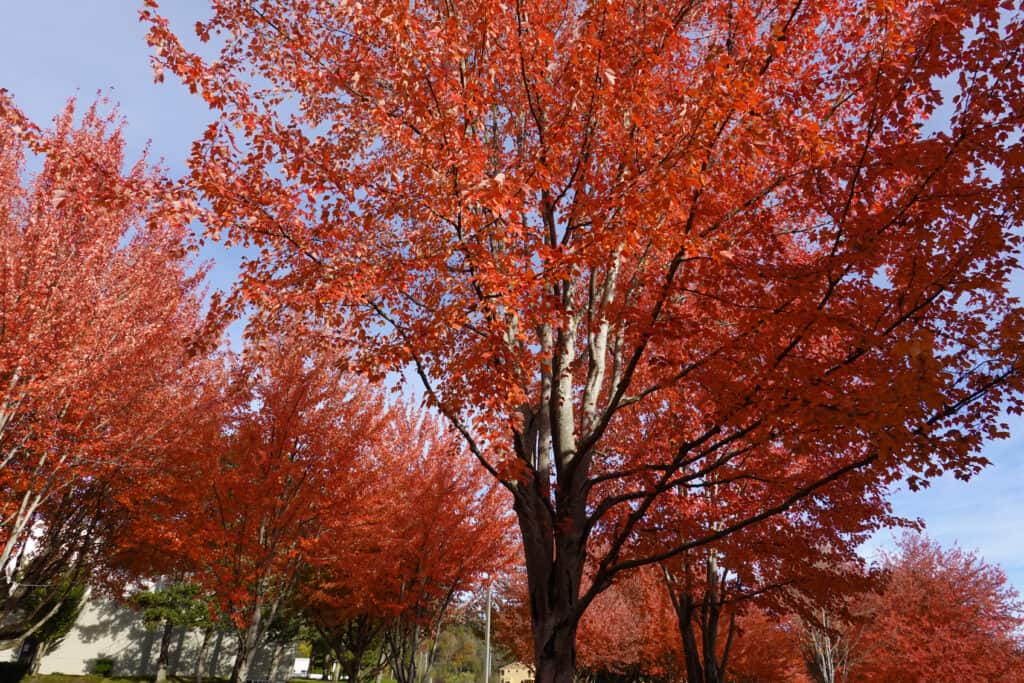Do you love maple trees that produce brilliant fall colors? If so, you’ll definitely want to learn about the Fall Fiesta® sugar maple and the Autumn Blaze maple.
In this guide, we’ll discuss the overlaps and differences of the Fall Fiesta® sugar maple vs. Autumn Blaze maple tree. So, we’ll cover the plant classifications, physical characteristics, native ranges and ideal growing conditions, landscape uses, and their fall foliage.
Well, without further ado, let’s jump into the wonderful world of these gorgeous Fall beauties.
Fall Fiesta® Sugar Maple vs. Autumn Blaze Maple Tree: A Quick Look
| Fall Fiesta® Sugar Maple | Autumn Blaze Maple | |
|---|---|---|
| Plant Classification | Acer saccharum ‘Bailsta’ | Acer x freemanii ‘Jeffersred’ |
| Physical Characteristics | Deciduous maple trees that grows to a height of 60-75 feet at maturity with a 30-45-foot spread. Forms a dense, rounded crown with an upright, fast, symmetrical growth pattern. Leaves are thick, glossy, leathery, and deep green in the Spring and Summer. Leaves can grow up to 6 inches long are simple, and deeply lobed. Mature bark is deeply furrowed and grey. | Fast-growing, deciduous maple tree that reaches 40-55 feet tall at maturity with a 30-40-foot spread. Leaves are light green in the Spring and Summer and not glossy. Leaves are 5-lobed, pointy, and have some irregularly toothed edges along the margins. Typically leaves grow 4-6 inches. Mature bark is light grey, |
| Native Ranges and Ideal Growing Conditions | Native to the hardwood forests of eastern North America and small parts of the Midwest. Grows in full sun to partial shade but prefers full sun. Prefers to grow in moist, well-draining, fertile, slightly acidic soil. Not tolerant of compacted soils, salt, or air pollution. Thrives in USDA Hardiness Zones 3-8. | Cross between red maple and silver maple. Red maple is native to parts of eastern North America and central and southeast US. Silver maples are native to parts of eastern North America, central, and southern US. Grows well in full sun to partial shade. Prefers moist, well-draining, slightly acidic soil. Has some drought tolerance once established. Thrives in USDA Hardiness Zones 3-8. |
| Landscape Uses | Excellent shade tree. Great specimen tree for large yards and parks. Intolerance of air pollution and road salt does not make this tree a candidate for urban spaces like sidewalks and parking lots. | A hardy hybrid that does well planted in urban spaces. Has sturdiness and adaptability of silver maple. Brilliant fall foliage makes it an excellent specimen and park tree. Roots are shallow so they won’t damage deeply laid pipes. They may surface and cause sidewalk splitting however. |
| Fall Colors | Fall colors are yellow, orange, and red with emphasis on orange and red. | Fall colors are blaze orange and brilliant red. |
Plant Classification
While both plants are part of the Acer genus of maple trees, they are distinct species. The Fall Fiesta® sugar maple is classified botanically as Acer saccharum ‘Balista’. The Autumn Blaze hybrid is classified as Acer x freemanii ‘Jeffersred’ or Acer x freemanii ‘Autumn Blaze’.
Since they belong to the same genus, both plants belong to the same botanical family. Some botanists place maple trees in their own genus, Aceraceae, while others consider maple trees as part of the Sapindaceae family.
Fall Fiesta® Sugar Maple vs. Autumn Blaze Maple Tree: Plant Characteristics
So, when it comes to distinguishing between the Fall Fiesta® sugar maple vs. Autumn Blaze maple tree, you’ll need to learn some important small distinctions to accurately identify them. Indeed, both plants share a number of characteristics typical of maple trees. Of course, these similarities include similar growing habits, bold fall foliage, and palmate, lobed leaves.
However, you’ll notice some differences between the trees in their leaf shapes, trunk textures/shades, shades of fall colors, and the overall shapes of the canopy and branching patterns.
Fall Fiesta® Sugar Maple vs. Autumn Blaze Maple Tree: Differences
Indeed, while both trees have palmate, 5-lobed leaves, the Autumn Blaze maple has irregularly toothed serrations along the margin. In comparison, the Fall Fiesta® sugar maple has 5-lobed, palmate leaves, but they are smooth along the margin and not quite as pointy. So, take a close look at the foliage to distinguish one from the other.
Additionally, the overall shape of the trees is a bit different from each other. The Fall Fiesta® sugar maple is known for having a lovely symmetrical, rounded, and dense canopy that makes it an excellent shade tree. While the Autumn Blaze maple has a similar spread at maturity of 30-40 feet, it has a less dense canopy and does not typically grow as symmetrically. Instead, this tree has an ascending branching pattern that narrows towards the top of the tree.
While both trees have grey trunks, the Fall Fiesta® sugar maple’s trunk is a bit darker shade of grey, deeply furrowed, and is not prone to splitting. In contrast, the Autumn Blaze maple’s trunk is a shade lighter grey and is prone to trunk splitting.
So, regarding Fall foliage, you can easily distinguish these two trees from one another. While both produce brilliant foliage displays, the shades of orange and red on the Autumn Blaze maple are noticeably brighter and more vivid.
Finally, the height at maturity of these two trees can distinguish them. While the Fall Fiesta® sugar maple tends to reach heights of 60-75 feet at maturity, the Autumn Blaze maple generally reaches heights of 40-55 feet.

The shades of orange and red foliage on the Autumn Blaze maple are noticeably brighter and more vivid than the Fall Fiesta® sugar maple.
©Dave & Margie Hill / Kleerup / Flickr – License
Native Ranges and Ideal Growing Conditions
So, the native range of both trees includes the hardwood forests of eastern North America and parts of the Midwest. However, the Autumn Blaze hybrid’s native range can also include larger parts of the central and southern US.
While both of these species are currently cultivated for nursery production, they are naturally occurring species. The Fall Fiesta® sugar maple is a naturally occurring variety of the sugar maple, Acer saccharum. As a hybrid, the Autumn Blaze maple is a naturally occurring cross between the red maple, Acer robrum, and the silver maple, Acer saccharinum.
Both trees thrive in USDA Hardiness Zones 3-8. They both prefer to grow in moist, well-draining, slightly acidic soil. The Fall Fiesta® sugar maple prefers full sun but tolerates partial shade, while the Autumn Blaze maple grows happily in full sun or partial shade. Once established, it has some drought tolerance.

sugar maples make excellent shade trees and do well in large yards and parks.
©Mircea Costina/Shutterstock.com
Fall Fiesta® Sugar Maple vs. Autumn Blaze Maple Tree: Landscape Uses
As trees with fantastic Fall foliage, both are excellent specimen trees that can thrive in spacious yards or parks. However, if planting in urban spaces, it’s advisable to choose the hardier, more adaptable Autumn Blaze maple tree over the less hardy, less pollution-tolerant Fall Fiesta®.
In urban areas, the Autumn Blaze maple can make a gorgeous addition to parks, medians, parking lots, and small yards. As a hardy tree, it can withstand many irritants of growing in urban areas such as road salt, air pollution, and small growing spaces. Its shallow root systems won’t disturb buried pipes, however, if planted too shallow, the roots can surface and crack sidewalks or parking lots.

The Autumn Blaze maple tree is a hardy hybrid that does well planted in urban spaces.
©LifeisticAC/Shutterstock.com
Fall Foliage
Alas, when comparing maple trees, it’s always good to consider how different species will display fall foliage. Since the Autumn Blaze maple has red maple in its lineage, this tree produces absolutely brilliant, bright red and orange fall colors. While it may not have as lovely of a growing pattern, its Fall leaves are some of the brightest of maple species. In comparison, the Fall Fiesta® sugar maple also produces absolutely lovely fall colors, but they tend to be more subdued shades of yellow, orange, and red.
Up Next
- Korean Maple vs. Japanese Maple: Autumn Color Trees
- Why Do Leaves Change Color in the Fall?
- Fireglow vs. Bloodgood Japanese Maple
The photo featured at the top of this post is © The Po/Shutterstock.com
Sources
- Missouri Botanical Garden, Available here: https://www.missouribotanicalgarden.org/PlantFinder/PlantFinderDetails.aspx?taxonid=270958&isprofile=0&
- Arbor Day Foundation, Available here: https://www.arborday.org/trees/treeguide/TreeDetail.cfm?ItemID=2572
- Missouri Botanical Garden, Available here: https://www.missouribotanicalgarden.org/PlantFinder/PlantFinderDetails.aspx?taxonid=255063&isprofile=0&
Thank you for reading! Have some feedback for us? Contact the AZ Animals editorial team.






